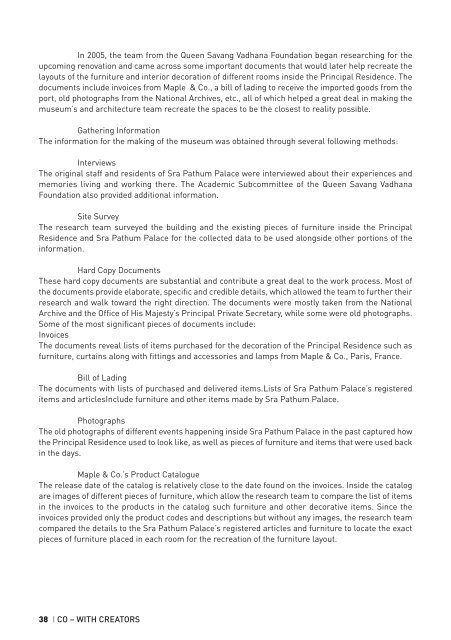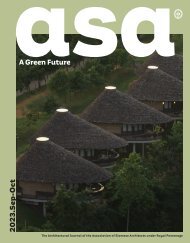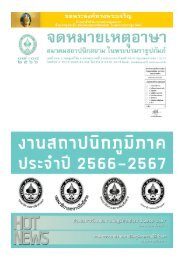สูจิบัตร งานสถาปนิก'65 : พึ่งพา อาศัย : Co-with Creators
Create successful ePaper yourself
Turn your PDF publications into a flip-book with our unique Google optimized e-Paper software.
In 2005, the team from the Queen Savang Vadhana Foundation began researching for the<br />
upcoming renovation and came across some important documents that would later help recreate the<br />
layouts of the furniture and interior decoration of different rooms inside the Principal Residence. The<br />
documents include invoices from Maple & <strong>Co</strong>., a bill of lading to receive the imported goods from the<br />
port, old photographs from the National Archives, etc., all of which helped a great deal in making the<br />
museum’s and architecture team recreate the spaces to be the closest to reality possible.<br />
Gathering Information<br />
The information for the making of the museum was obtained through several following methods:<br />
Interviews<br />
The original staff and residents of Sra Pathum Palace were interviewed about their experiences and<br />
memories living and working there. The Academic Subcommittee of the Queen Savang Vadhana<br />
Foundation also provided additional information.<br />
Site Survey<br />
The research team surveyed the building and the existing pieces of furniture inside the Principal<br />
Residence and Sra Pathum Palace for the collected data to be used alongside other portions of the<br />
information.<br />
Hard <strong>Co</strong>py Documents<br />
These hard copy documents are substantial and contribute a great deal to the work process. Most of<br />
the documents provide elaborate, specific and credible details, which allowed the team to further their<br />
research and walk toward the right direction. The documents were mostly taken from the National<br />
Archive and the Office of His Majesty’s Principal Private Secretary, while some were old photographs.<br />
Some of the most significant pieces of documents include:<br />
Invoices<br />
The documents reveal lists of items purchased for the decoration of the Principal Residence such as<br />
furniture, curtains along <strong>with</strong> fittings and accessories and lamps from Maple & <strong>Co</strong>., Paris, France.<br />
In addition, the items discovered inside the Principal Residence such as furniture frames,<br />
curtains, lamps, etc. became an important piece of information for the design and research team to<br />
speculate and recreate the furniture layout of each room, as well as the restoration of the damaged<br />
items. With this information at hand, they reproduced the items that could no longer be found in the<br />
form of working drawings before proceeding to find the capable manufacturers. This included<br />
personal visits at Maple & <strong>Co</strong>. and a number of institutions in France where the original pieces were<br />
reproduced.<br />
“Putting Together the Pieces”<br />
The restoration process was carried out <strong>with</strong> different items found inside Sra Pathum Palace<br />
such as the furniture frames, which were polished, cleaned and repainted by experienced artisans. An<br />
additional layer of paint job was done to create the timeworn finishes of used items before the pieces<br />
were installed back to their original positions.<br />
For the items such as fabrics, curtains and tapestries, which were already in their unusable conditions,<br />
the research team studied and compared <strong>with</strong> the remaining articles from the fabrics found folded and<br />
kept underneath a piece of furniture. Some were compared to images on old photographs and items<br />
listed on the invoices. The team then searched for the manufacturers, both in Thailand and overseas,<br />
to reproduce the pieces and reinstall them to where they were originally placed.<br />
The ‘patchwork’ approach of the renovation of the interior architecture includes additional<br />
facilities installed, but only the ones necessary for the museum function, from air-conditioning system,<br />
new restrooms, small elevators, fire alarm and security system. Meanwhile, the nearby areas were<br />
managed <strong>with</strong> new vehicular and pedestrian circulations, as well as entrances and exits. Several old<br />
buildings in the perimeter were renovated for the safety of the palace’s residential zone while still<br />
being able to accommodate the public functionalities of the museum. Visitor number is monitored and<br />
controlled to prevent the Principal Residence’s architectural structure from being overcrowded and<br />
damaged.<br />
Bill of Lading<br />
The documents <strong>with</strong> lists of purchased and delivered items.Lists of Sra Pathum Palace’s registered<br />
items and articlesInclude furniture and other items made by Sra Pathum Palace.<br />
Photographs<br />
The old photographs of different events happening inside Sra Pathum Palace in the past captured how<br />
the Principal Residence used to look like, as well as pieces of furniture and items that were used back<br />
in the days.<br />
Maple & <strong>Co</strong>.’s Product Catalogue<br />
The release date of the catalog is relatively close to the date found on the invoices. Inside the catalog<br />
are images of different pieces of furniture, which allow the research team to compare the list of items<br />
in the invoices to the products in the catalog such furniture and other decorative items. Since the<br />
invoices provided only the product codes and descriptions but <strong>with</strong>out any images, the research team<br />
compared the details to the Sra Pathum Palace’s registered articles and furniture to locate the exact<br />
pieces of furniture placed in each room for the recreation of the furniture layout.<br />
38 I CO – WITH CREATORS<br />
CO – WITH CREATORS I 39


















